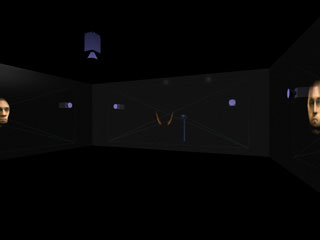Argument - Process - Physical Space - Psychological Aspects
Peripheral Agency is a real-time video-optical installation. It operates on the relationship between presence and image in a way that directs activity toward the periphery of perception. When a person walks into a room where it is installed, the system constructs a 3D computer model of their head from video footage gathered from a series of cameras embedded in the walls of the room. Once the system has constructed the head model, it determines the direction of the agentís gaze from a combination of information derived from overhead and side-view cameras. The system then back-projects a series of three images on the walls in the room, all related through a precise geometric configuration determined by the optics of the eyes.An image of the back of the personís head is projected in the direct line of sight of the personís gaze, and images of the personís face are projected at the peripheral edges of the personís vision on either side. No matter how the person moves or shifts his gaze, the system will retain this fixed relationship. In addition to the projected images, there is a slight reflection of the installation space created by the projection surface, generating layered imagery that composites projected images with a direct optical image of the installation space. Even projected images on opposing walls will reflect on the surface albeit at a reduced brightness. The projection surfaces themselves are a type of translucent glass that images rear-projected light and slightly reflects light from the front. Behind the projection surfaces, the space is treated to give the effect of a fathomless black such that there is no marker to judge the scale of the space. Since the composited projected-reflected images exist within the glassy surface, they attain a crystal-like quality, extending the physical space into a realm of otherness and heightening the images sense of the uncanny.